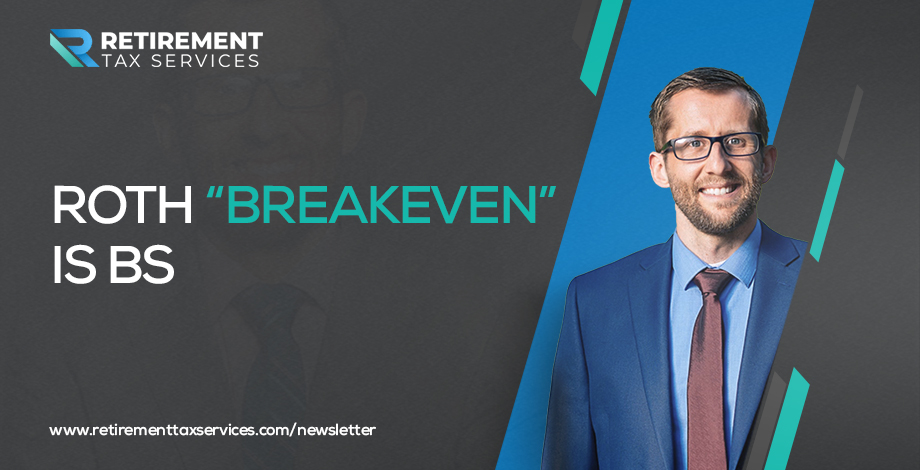
Roth “breakeven” is BS
By this point, I’m sure you can tell we’re a big fan of Roth conversions at Retirement Tax Services. That doesn’t mean they should be done every year for everyone. It does mean you should understand how to evaluate whether they make sense for a given client in a given year, AND you need to be able effectively communicate the value proposition of making that choice.
To be clear, there is NO SUCH THING as a break-even point for Roth conversions!
Roth conversions make sense for clients who are concerned that tax rates might go up in the future. Whether they go because the clients’ income goes up or because Congress makes changes, either way, they will be better off locking in today’s rates they expect to be lower instead of waiting until a future year where they expect rates to be higher. There is, of course, the added benefit of Roth dollars creating flexibility in the form of a tax free option when unexpected cashflow needs come along.
Nowhere in that conversation is there discussion of “after x number of years, Roth will make more sense”. Time value of money doesn’t come into it. Plenty of people (especially online) will try and make arguments about opportunity costs and the rate of return in a brokerage account if you use after-tax dollars to pay the taxes on the conversion, but all of that is based on a poor understanding of how the tax code works in practice. Let’s take an example:
A client has $100,000 IRA and $24,000 in cash, and their only options are to leave the IRA as is and invest the cash in a taxable brokerage account or to convert the $100,000 to Roth at a 24% tax rate leaving them with $100,000 in Roth and $0 in cash. Now let’s fast forward 10 years and assume that everything has doubled, which situation leaves the client better off?
In the first scenario, the client now has $200,000 in an IRA and $48,000 in a taxable brokerage account, but there is a tax liability associated with both of those accounts. In fact, the tax liability is ~$52,512…give or take ($48,000 on the IRA at 24% and $4,512 on the brokerage at 18.8% on the capital gains in the brokerage account).
There are absolutely assumptions involved there, but if, after 10 years, those accounts doubled and the client had to withdraw the money all at once, they would end up with $195,488. In contrast, if they had converted to Roth and the account had doubled, the client would have $200,000 of tax-free money to use however they’d like. Does that mean Roth is ALWAYS better?
No, that would be an overgeneralization and simply incorrect.
The example here simply illustrates that time value of money and “breakeven” analysis should not be anywhere in the conversation. You need to focus on the right things to help your client make the best choice for their situation.
Take the time to understand the real value of a strategy before you get caught up in internet nonsense.
Happy Tax Planning!
P.S. On May 7th, 2025, we’ll be hosting our next CE-eligible webinar, and we will be covering tax planning strategies you can identify and implement using your clients’ 2024 tax return. Save your seat, and we’ll see you there.